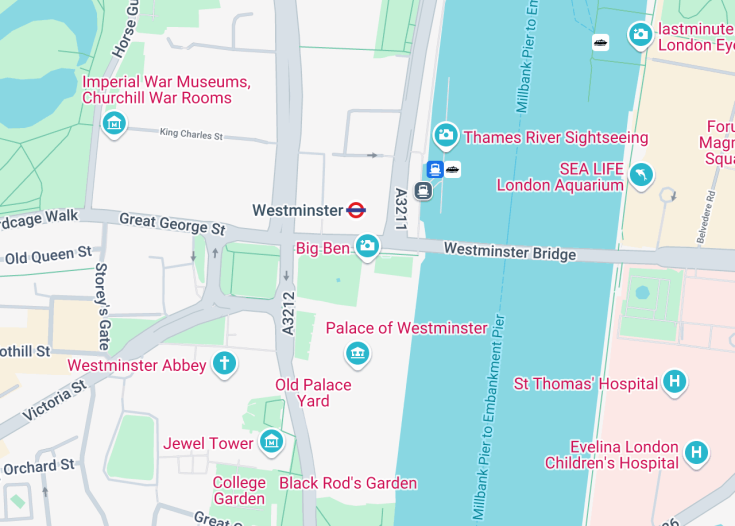Big Ben, referred to often simply as the clock tower, is one of London’s most iconic landmarks. Officially named the Elizabeth Tower, it stands at the north end of the Palace of Westminster. Home to the Great Bell, the nickname Big Ben actually refers to the bell itself, rather than the tower. This striking example of Gothic Revival architecture draws tourists from around the globe who come to hear its famed chimes, which have marked the hour with impeccable accuracy since 1859. Visitors cherish the rich history and political significance imbued in this monumental clock.
Carry a camera to capture the intricate details of Big Ben’s architecture and the dynamic surroundings of the Westminster area.
Check the parliamentary schedule ahead of your visit; you may have the chance to enter the Westminster Palace and learn more about its history.
The Icon of London
Big Ben, located at the north end of the Palace of Westminster in London, is not just a clock tower, but a symbol of both London and England. Officially named the Elizabeth Tower in 2012 to celebrate the Diamond Jubilee of Elizabeth II, it is often referred to by the name of its main bell. The tower holds the second largest four-faced chiming clock in the world and was once the tallest clock tower globally. The significance of Big Ben lies not only in its architectural achievements but also as a central point of New Year’s celebrations in the UK, where its chimes mark the start of a new year. A visit offers tourists a glimpse into the UK’s history and its ongoing political life, as it stands adjacent to the Houses of Parliament, the center of British politics. Though currently under restoration, Big Ben remains a must-visit for tourists, symbolizing resilience and continuation amidst the evolving British landscape.
Explore the Surrounding Area
While Big Ben itself is an iconic structure, the surrounding area of the Palace of Westminster offers additional attractions. Tours of the Houses of Parliament provide a deeper understanding of the UK’s political history and present-day workings. Visitors can also enjoy stunning views of the tower and the Thames River from Westminster Bridge. Don’t miss the chance to hear the famed chimes of Big Ben, especially memorable during New Year’s Eve celebrations.
The Great Bell and Its Chimes
One notable aspect of Big Ben is its main bell, known as the Great Bell. Despite common misconceptions, Big Ben is not the tower itself but this 13.5-ton bell. The original bell cracked under testing and was recast in 1858. Its distinctive chimes, heard across London, have been broadcasted by the BBC since 1923, serving as a comfort and reminder of home for listeners worldwide during times of war and peace. This historical element highlights not only a feat of engineering but also a piece of living history that has been part of British life for over 150 years.
discover the charm of Big Ben
The iconic Big Ben is renowned largely as a must-visit for both history buffs and architectural aficionados. However, it holds appeal across all age groups, including children, couples, and older visitors. From its awe-striking clock face to the historical significance of the Houses of Parliament, which it adjoins, there is much for everyone to enjoy and learn.
when is the best time to visit?
Visiting Big Ben can be most rewarding during the late spring or early autumn months, when London’s weather is most temperate. This timing avoids the peak tourist season of summer, offering a more relaxed experience.
Annual Events
For those looking to enhance their visit, attending the New Year’s Eve festivities near Big Ben is highly recommended. The spectacular fireworks and celebrations offer a unique viewpoint with the chiming of the clock at midnight creating a magical experience.
accessibility and limitations
The accessibility of Big Ben, mostly suited for viewing from the outside due to renovation works, deserves attention for an informed visit.
Accessibility
Limitations
- Age Restrictions: Currently, no tours available to the public.
- Photography: Photography might be restricted during specific hours or events.
Notes to visitors
- Preparation for weather changes is advised as much time is spent outdoors.
- Expect security screenings at nearby buildings.
General informations
Location
Located adjacent to the Houses of Parliament in Westminster, Big Ben stands near significant landmarks such as Westminster Abbey and the Thames River.
Address:
Westminster, London SW1A 0AA, United Kingdom
Opening hours
Big Ben is viewable at all hours but does not have accessible tours for the public currently due to ongoing renovations.
Reaching big ben
Car
Given its central location, Big Ben can be accessed by car though parking may be limited. Local parking facilities are available but subject to charges.
Public transport is highly recommended. The Westminster Station is the nearest tube station.
Nearby Attractions
Explore other nearby attractions to maximize your visit:
- Westminster Abbey – 0.5 miles (0.8 km)
- London Eye – 0.8 miles (1.3 km)
- Thames River Cruise – 0.6 miles (1 km)
- National Gallery – 1.2 miles (2 km)
- Trafalgar Square – 1.5 miles (2.4 km)
- St James’s Park – 0.8 miles (1.3 km)
Common questions
What architectural style is Big Ben?
Why is Big Ben called Big Ben?
How accurate is Big Ben?
How often is Big Ben maintained?
What events caused Big Ben to stop in the past?
Can the public visit the inside of Big Ben?
What materials were used in the construction of Big Ben?
What does the inscription on Big Ben mean?
How are the clock faces of Big Ben illuminated?
What is the weight of the bell in Big Ben?
How was Big Ben affected during World War II?
Who designed Big Ben and when was it completed?

Is Big Ben in London worth visiting?
Big Ben, standing tall at the north end of the Palace of Westminster in London, is an iconic landmark globally recognized. A visit offers tourists not just a view of the splendid clock tower but also delves into the rich history and engineering marvel of the late 19th century. Your trip to London would arguably be incomplete without seeing this quintessential symbol.
However, potential visitors should note that ongoing renovations can sometimes restrict access and spoil the visual aesthetics, which could be disappointing. Furthermore, the area is often crowded, which can somewhat detract from the experience. Careful planning regarding timing could enhance your visit. Despite these issues, the historical and cultural value of seeing Big Ben firsthand makes it generally worthwhile.










